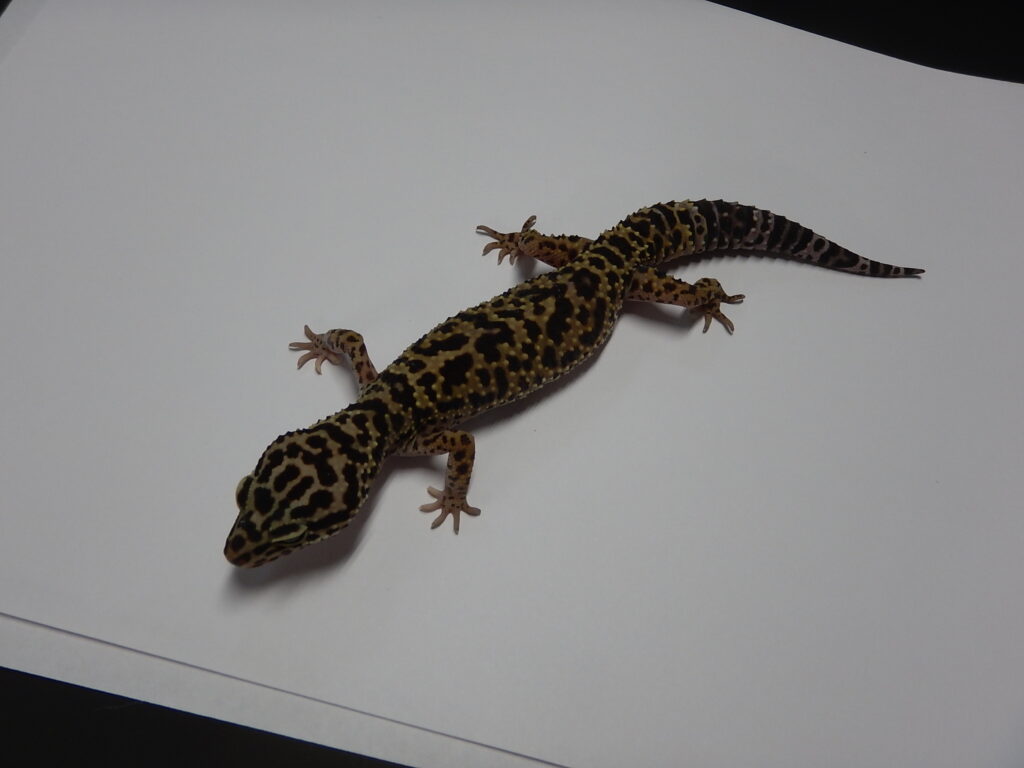I originally learned about E. m. afganicus through looking at the “Wild-Type” listings of available leopard geckos online. They are a smaller subspecies of macularius and tend to sit at around 30-40 grams during adulthood. They are well-known for their busy pattern and bold markings. They have also been observed to be more communal than other subspecies of macularius.’1 I learned of afganicus around the time when I discovered the vast community of leopard gecko breeders and was starting to become fascinated with the concepts of genetics, line breeding and subspecies. E. m. afganicus are a subspecies of leopard gecko that has been preserved in captivity in that there are specimens who have exclusively afganicus subspecies lineage. Though, through various sources I have gathered that they have been crossed into other subspecies of macularius. For example, Matt Baronak has successfully crossed afganicus into his macularius sp. to create his world-renown G-Project, a selectively bred-line of leopard geckos with unique contrast.2′
G-Project leopard gecko below:

I was inspired to purchase my own afganicus at the Hamburg Reptile Show in Pennsylvania not only to for crossing potential but to preserve the subspecies in catpivity. I bought two with the intention of breeding them in the future: a temperature sexed male and a temperature sexed female. Although, they both turned out to be females.
They have identification codes; the first one is #010 and the second one is #011. They are both maintaining a weight of 35 grams at the moment. I raised them in the same enclosure and they remain together today. I have not noticed any aggression or any behavior indicative of a hierarchy.


During the spring of 2021, on the first of May actually, I noticed a pinkish circle forming in an ovary of one of the females: an ovulation. The next day, I noticed the same circle forming in one of the other female’s ovaries. Here is what an ovulation in a leopard gecko would look like:

As I planned to do when I would eventually see these ovulations, I introduced the two females into two different males’ cages that were previously selected and left them alone overnight. The two males were macularius sp. I removed the females the next morning and put them back in their cage.
On May 16th, #011 laid two eggs. And then laid two more on June 14th. #011 laid seven total clutches of two eggs, the last clutch laid on October 20th, laying a total of 14 eggs. #010 laid a clutch of one egg on June 18th, and a final clutch of two eggs on October 27th, laying a total of six clutches and eight eggs. I can tell that they will not be laying any more eggs because their ovaries are white. When I collected the eggs, I placed them in an incubator that was kept at around 90 degrees fahrenheit.
These levels of egg production and frequency are consistent with my female macularius sp. But, none of the eggs hatched. There could be a few possible suspects to this. First, it is possible that I did not provide the nutrients that are specifically required by afganicus females. I noticed that the eggs began to dry out and shrivel right around two weeks after they were laid, indicating that I could have been keeping the eggs at either the wrong temperature or the wrong humidity, or a combination of the two. Finally, it might be that it is not possible to hybridize afganicus and macularius sp. When I originally shined a light under the eggs after they were laid, I noticed no embryo in the egg. The egg would be completely yellow. Here would be an example of an embryo in a leopard gecko egg:

Also, I shined lights under the eggs that had shriveled up two weeks after they were laid, and I still saw no sign of an embryo presence ever there: I saw all yellow.
I would love to hear any other possible causes or about anyone else’s experience crossing afganicus into macularis sp. Please contact [email protected].
References:
- “Uncovering SaSobek Part IV: Eublepharis subspecies and Hardwickii” Strength in Leos Podcast, Matt Baronak and Evan Wooldridge, 2021. Retrieved April 1st, 2021.
- “Uncovering SaSobek Part IV: Eublepharis subspecies and Hardwickii” Strength in Leos Podcast, Matt Baronak and Evan Wooldridge, 2021. Retrieved April 1st, 2021.
- “Types of Pet Reptiles – Pet Supermarket” Pet Supermarket, Isiaah. Retrieved November 17th, 2021.
- “Female-Leopard-Gecko-Ovulating” Prova Reptile. Retrieved November 17th, 2021.
- “Urgent are these eggs fertile?” Morph Market Community, @crittercreatures, 2019. Retrieved November 17th, 2021.